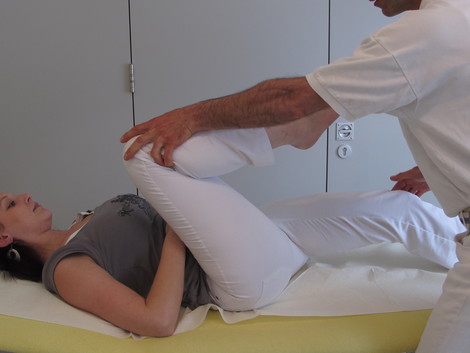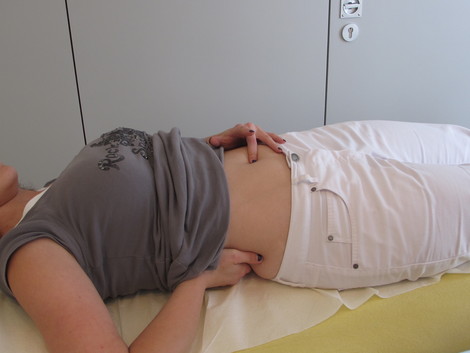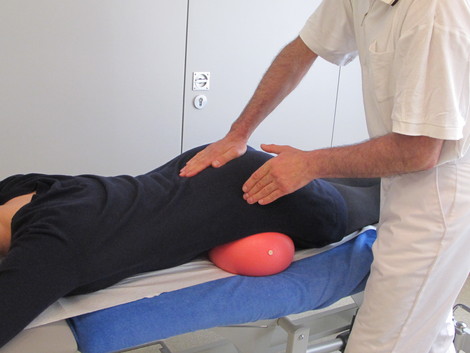The causative treatment of unspecific low back pain by integral orthopedics
Introduction
The cause of unspecific low back pain is seen in a stress- and sympathicotonia- induced vegetative hypertension with regulation rigidity between sympathocotonia and parasympathicotonia. This causes a tension and dysbalance of the dorso-lumbar and lumbopelvic fascia and muscles. In stead of neural therapy injections into the umbilical fascia the integral orthopedis show an approach witch combines osteopathic abdominal fascia relaxation and at the same time relaxation of the dorso-lumbar and lumbopelvic fascia and muscles. With the umbilical integration technique at the same time the vegetative hypertension and regulation rigidity will be resolved together with the lokal muscle and fascia tension.
Treatment consisted of the following steps:
1. Manual relaxation of the fascial system by means of “umbilical integration”
2. This procedure resolves the vegetative regulation rigidity in the adrenal cortex and the solar plexus
3. Simultaneous relaxation of first sources of desorder the than the lumbopelvic muscles and fascia
4. Resolution of the sacroiliac joint blocks as well as pelvic muscle tensions by means of ”sacral bone integration“
Steps 1-4 be performed as well by patients as also by family members.
As for a preparation of the patient following steps are often necessary to reduce the inner stress which is correlated to the pelvic torsion.
Pelvic torsion as a indication of stress induced vegetative hypertension:
The pelvic torsions shows a contracture of the iliopsoas muscle dominating on one side and the back muscles especially the quadratus lumborum on the other side.
On the side of the iliopsoas shortening the leg lifts when the other knee is led to the body. On the side of the shortening of the back muscles the abduction of the bowed leg is restricted, caused also by blockade of the sacroiliacal joint.
Possible inner stress causes:
These show themselves by a spontaneous resolution of the pelvic torsion:
1. Removal of foreign objects such as belly button piercing (!) or ear rings
2. Jaw relaxation, first with two cotton rolls in the jaw for diagnostic purposes, then manually by moving slightly the jaw either to the right or the left.
2. Refinement of scars and throat by “scar integration” technique
Practice
1.Umbilical integration
The navel is moved very softly with one finger in the direction with the least resistance.
With two fingers of the other hand during the first treatment and later after infections or prolonged periods of stress the upper front region of the neck with the tonsilregion is held for a minute, to be dejamed and reintegrated in the system.
The most comfortable direction of the navel is again checked and hold, while with the other hand regions of pain or tension are hold. In case of back pain the lumbar region is hold for few minitus first on one side than on the other. Normally muscles tensions and joint blocks are resolved and one senses the cleared energy and blood flow in form of pleasant warmth and relaxation and a feeling of well-being. Instead of manually dejaming the tonsil region, it can also be irradiated with a laser pointer for a short time.
2.Cicatrical integration
If there are any other scars, they will be searched one after the other for their special sensitivity or increased tension and then moved in the most comfortable and softest direction. With one finger ot the other hand the navel will be relaxed as mentioned above. In stead of relaxing the navel with the other hand it is also possible to touch other pain spots with the second hand. Also it is possible that the patient relxes his navel with one hand and with the other hand holdes pain spots, while the therapeut moves the scares with his fingers very very softly in the direction of less resistence and more well feeling.
3.Sacral bone integration:
In order to relax the very important sacrtoiliacal joint the patient lies on the stomach with two cussins or softballs underneath his pelvic bones.
The therapeut puts one hand on his or her sacral bone and the presses two fingers of the other hand on painfull parts of the dorsal pelvic area. These can be either the sacroiliacal joint or the gluteal muscles or the dorsal femur or the coccygeal bone. Now he moves the sacral bone in different directions and holds it aproximately two minutes in the direction which gives a relaxation the pain spot. In this manner he continues until all pain spots are relaxed.
Discussion:
The cause of many illnesses is seen in the integral orthopaedics like in the Chinese medicine by a disturbance of the energy circulation, caused by stress in its different forms. As a result of physical or emotional stress in the form of a unique or chronic overstrain or mal loading, which can be overloaded like a chain reaction and muscular hardenings and/or joint blockings are spreading out.
Among the traumatically conditioned restriction of the individual maximum resilience the well-known fields of disorder of the neural therapy, especially scars, are of importance.
The persistent inner and outer stress leads to a vegetative hypertension with a rigidity of regulation through an overstrain of endogenic regulatory mechanism of the hypothalamus-hypophysis-adrenocortical axis.
As a result of irritations of the bodily information system caused by fields of disorder and the stiffness of regulation depending on stress, traditional treatments with manual and/or other physical therapy or acupuncture cannot achieve to a longer durable recovery.
The durable state of stress leads to a weakness of the immune system among other things caused by a hormonally suppression of the thymus gland as well as by a disturbance of regulation for the solar plexus and the adrenal glands with reduced blood flow, disturbed tonicity of the smooth musculature of the hollow organs and a minimized cell formation at the region of the abdomen organs, especially of the bowel wall with the local lymphatic part of the immune system.
General health and efficiency are additionally reduced by stress, cellular regeneration of energy as well as by the nutrient absorption and nutrient exploitation. A redistribution of the brain vascularity for the benefit of reflectorily working centres stimulates depressive moods and makes higher efficiency of the brain more difficult (Lipton). The access to inner sources of happiness, force and creativity as well as harmonious interpersonal relations is more difficult. The human being only thinks of his illness and restricts his life to the minimum.
Conclusion:
In view of the pathogenesis of unspecific back pain, the following chain of causes has analogously been determined:
1. Stress-related irritation of the connective tissue associated with impaired information transmission within the basic extracellular system and tension of the fascial system
2. Overload of the hypothalamic-pituitary-adrenal axis with sympathicotonia-induced vegetative regulation rigidity
3. Muscular imbalance in the torso, primarily with contracture of the quadratus lumborum muscle, secondarily of the iliopsoas muscle, typically mutually as pelvic torsion, often associated with a difference in the length of the legs
4. Impaired joint function, primarily of the sacroiliac joint
5. Other functional irritations, including the dorso-lumbar and pelvic region, symphysis, head- and jaw joints, hips, calves, feet
6. Pain-related, psychovegetative, emotional, mental and social stress
Every link of the chain can have a detrimental effect on the remaining links.
Results:
1. Pelvic torsion is considered the primary, often low-symptom reaction of the musculoskeletal system to even minor stress which severely reduces the back strength.
2. Pelvic torsion and Patrick’s sign or hip flexion contracture can also be used as stress indicator in back pain.
3. Umbilical and sacral bone integration which can also be performed by the patients represent an effective basic treatment as well as prophylaxis for unspecific low back pain.
more information by www.dr-kermani.de: integral orthopedics

pelvic torsion: Iliopsoas contraction

pelvic torsion: back muscle contraction with blockade of the sacroiliacal joint( Patrick sign)

navel integration with relaxation of the lumbopelvic muscles navel integration with relaxation of the shoulder muscles

sacral bone integration
